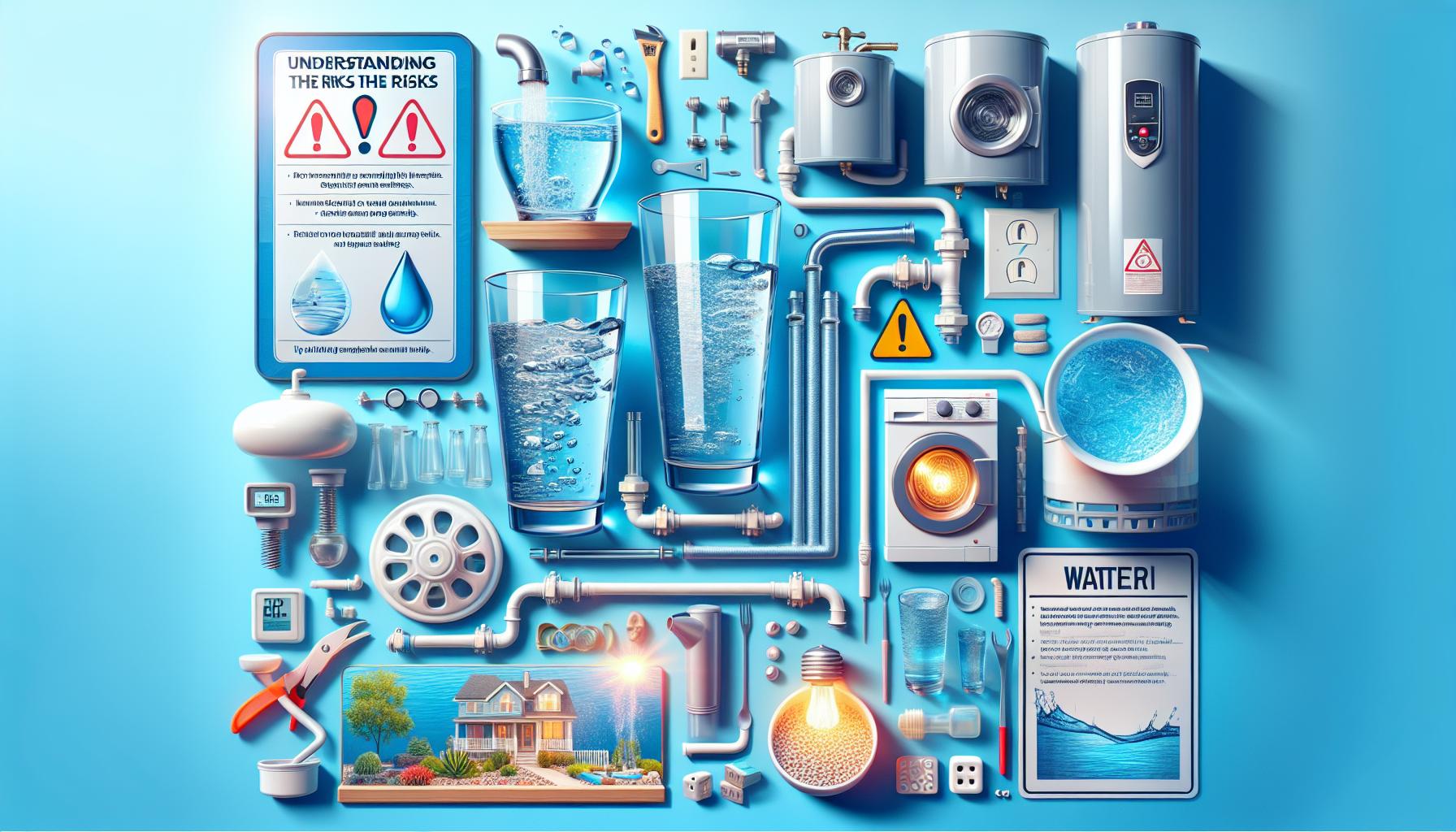Transporting a water heater often raises questions about the safest methods. While it may seem convenient to lay it down, this approach can lead to internal damage and potential warranty issues. Understanding the risks and proper techniques for moving your water heater is crucial to ensure functionality and longevity, making this topic both relevant and essential for homeowners and DIY enthusiasts alike.
Understanding the Risks of Transporting a Water Heater Horizontally

Transporting a water heater horizontally can present unexpected challenges and risks. While some believe that laying a water heater down is a convenient method for moving it, this practice can potentially lead to significant issues. For instance, internal components may become damaged or dislodged during transport, possibly resulting in malfunctions or leaks once the unit is reinstalled. Moreover, experts highlight that laying the water heater down can trap air in the system, which may affect its functionality and increase risks of leaks when reconnected and filled with water.
Potential Damages from Horizontal Transport
When considering whether you can lay a water heater down to transport it, it’s essential to recognize the potential damages that could occur. These include:
- Internal Component Damage: Water heaters contain various parts that can be affected by being placed horizontally. For instance, the tank’s integrity could be compromised, and items such as the heating element or dip tube can be misaligned.
- Air Trapping: Laying a heater down can create pockets of air within the tank. This may lead to inefficient operation and issues during the heating process.
- Increased Risk of Leaks: Any compromised seals or loose fittings can become problematic, increasing the chance of leaks once the water heater is in operation again after transport.
Long-term Consequences
Improper transportation of a water heater can have far-reaching effects beyond just the immediate risk of damage. Neglecting to handle the appliance correctly may void warranties, cutting off an avenue for repairs and support. Additionally, the lifespan of your water heater may be significantly reduced if it’s not transported in the correct orientation. Many manufacturers recommend against horizontal transport because of these reasons, highlighting that improper handling could lead to premature failure of the unit.
By adhering to proper guidelines, you can avoid these pitfalls and ensure that your water heater remains in excellent working condition. If you must transport a water heater, consider using tools like a dolly or securing it firmly in an upright position to mitigate risks. Understanding these details can be critical in making informed decisions about transporting your water heater safely and effectively.
The Right Way to Prepare Your Water Heater for Moving
Before you embark on the challenging task of relocating your water heater, it’s essential to understand the necessary preparations to ensure a smooth moving process. One of the most critical considerations is whether you can safely lay a water heater down for transport. While some homeowners might think it’s acceptable to do so, this can lead to significant risks, including damage to the unit itself or leaks in the plumbing connections. Thus, knowing the right way to prepare and move your water heater is not only practical but vital for ensuring its functional integrity after relocation.
First and foremost, you must disconnect the water heater before moving. Turn off the power supply or gas supply, depending on the type of heater, and allow the unit to cool down completely. This step is crucial to prevent any accidents or injuries during transport. Next, shut off the cold water supply and drain the heater by connecting a garden hose to the drain valve and directing the water into a suitable container or outside. Draining the heater thoroughly minimizes the weight and the risk of water spillage, making the transport process smoother.
Preparing the Space
Once your water heater is disconnected and drained, prepare the areas involved in the move—the current location and the new space. Create ample room to maneuver the heater out, removing any obstacles that could hinder the moving process. Additionally, if you plan to lay the heater down for transport, consider using a protective padding, such as moving blankets, to safeguard it against scratches or dents.
Protecting the Heater
As you proceed, consider how to secure the heater if you choose to transport it in an upright position. Laying it down, especially on its side, can cause structural and mechanical issues since the internal components are not designed to handle that position for an extended time. If you must lay it down due to space constraints, make sure it’s done on a flat surface, ideally cushioned, and secured well to avoid rolling during transit.
Ultimately, understanding the nuanced approach to moving such a significant appliance will help you avoid common pitfalls associated with transporting a water heater. Prioritizing safety and thorough preparation will ensure that your endeavor runs as smoothly as possible. Remember that professional help is always an option if you feel uncertain about managing this task on your own.
Essential Tools for Safe Water Heater Transportation
When preparing to move a water heater, having the right tools at your disposal can make all the difference between a smooth transition and a potential disaster. The risk of damage, particularly when considering whether you can lay a water heater down to transport it, underscores the necessity of using appropriate equipment to ensure safety and preserve the integrity of your appliance. Investing in the right tools not only helps in managing the physical demands of moving but also minimizes the chances of accidents and equipment failure during transit.
Essential Equipment for Moving a Water Heater
To safely transport a water heater, consider the following essential tools:
- Dolly or Hand Truck: A sturdy dolly or hand truck is crucial for maneuvering your water heater without straining your back. This equipment allows for easy lifting and transporting while keeping the heater in an upright position, which is vital to avoid internal damage.
- Straps and Ratchet Straps: Securely strapping the water heater to the dolly helps prevent it from shifting during transport. Ratchet straps provide an added layer of security, ensuring the heater remains in place regardless of the movement.
- Moving Blankets: These are essential for protecting the water heater’s surface from scratches and dings. Wrapping the appliance with moving blankets can also help keep it insulated during transportation.
- Socket Set and Wrench: Depending on your model, you may need these tools to detach the water heater from its current plumbing connections safely. Ensure you have the right size to avoid stripping nuts and bolts, which can complicate the moving process.
Protective Gear
While the right equipment is fundamental, personal protective gear is also important during the moving process. Consider wearing:
- Gloves: Protect your hands from sharp edges and the heat of metal components.
- Steel-Toed Boots: These provide extra protection in case heavy components shift unexpectedly.
- Back Support Belt: Utilizing a lifting belt can help reduce back strain when maneuvering the heater.
Preparation and Planning
Before attempting to move your water heater, preparation is key. Proper planning includes measuring doorways and hallways to ensure the heater can pass through without obstruction. Disassembling any protruding parts will aid in safely navigating tight spaces.
| Tool | Purpose |
|---|---|
| Dolly or Hand Truck | For lifting and moving the heater |
| Straps | To secure the heater during transport |
| Moving Blankets | To protect the heater from scratches |
| Socket Set | To detach plumbing connections |
| Protective Gear | To ensure personal safety |
By equipping yourself with these essential tools and taking the necessary precautions, you can transport your water heater safely and efficiently, avoiding potential hazards and ensuring your appliance remains in optimal condition during its journey.
Step-by-Step Guide to Lifting and Securing Your Water Heater

Transporting a water heater can be daunting, but understanding how to lift and secure it properly can make the process much smoother. Many people wonder about the safety of laying a water heater down for transport. While it is possible in some cases, proper lifting techniques and securing methods are crucial to prevent damage to the unit and ensure safety during transit.
Preparing for the Move
Before lifting the water heater, ensure that you’ve got all the necessary equipment ready. This includes:
- Packaging Materials: Ensure the heater is still in its packaging if new.
- Straps or Ropes: Use strong nylon straps or ropes for securing the heater.
- Dolly or Hand Truck: A dolly can make moving the heater easier and safer, especially if it’s heavy.
- Protective Wear: Consider gloves and proper footwear to avoid injury.
Lifting the Water Heater
When it comes to lifting the unit, follow these essential steps to avoid injury and damage:
- Get Help: Always have at least one other person assisting you. Water heaters can be cumbersome and heavy.
- Positioning: Stand on opposite sides of the heater. This helps maintain balance while lifting.
- Lifting Technique: Bend at your knees, not your waist. Keep your back straight and lift with your legs. Engage your core to maintain stability.
- Avoid Tilting: If the heater must be moved laying down, ensure it is laid gently to minimize internal component stress.
Securing the Water Heater
Once the heater is lifted and on the dolly, proper securing is essential to prevent it from shifting during transport:
- Wrap with Straps: Use the straps or ropes to tightly secure the heater to the dolly. Make sure it is snug and won’t move.
- Positioning in Vehicle: If transporting in a truck or van, ensure the heater is placed upright if possible. If it must lay down, ensure cushioning is used underneath and around it to prevent shifts.
- Final Checks: Before driving, double-check the security of the heater. If it’s moving during transport, it can lead to damages that might void warranties.
The key to safely moving a water heater lies in the preparation, lifting techniques, and securing methods employed. By adhering to these steps, you can transport the unit effectively, reducing the risk of damage both to the heater itself and your vehicle.
Tips for Protecting Your Water Heater During Transport
Transporting a water heater requires careful planning to avoid potential damage. Many homeowners underestimate the risks associated with moving these appliances. Whether you’re moving into a new home or just relocating your unit, taking the right precautions can help ensure your water heater arrives intact.
Use Appropriate Packaging
Whenever you move a water heater, keeping it in its original packaging is crucial. This packaging is designed to protect the unit from external impacts. If you have already discarded the packaging, consider wrapping the heater in thick blankets or moving pads. Pay special attention to corners and edges, which are most susceptible to damage.
Secure the Heater Properly
When transporting the heater, whether upright or horizontally, use sturdy straps or ropes to secure it within the vehicle. This step prevents any unnecessary movement during transit that could lead to structural or internal damage. If you decide to transport the unit laying down, be aware that this could increase the risk of misalignment of internal components—a factor that can lead to leaks or malfunctions down the line. In fact, many manufacturers recommend against this method to protect the unit and maintain warranty coverage[2].
Avoid Laying It Down
While some may consider laying a water heater down to fit it into the vehicle, this method comes with significant risks. A water heater’s internal components are sensitive to position changes. Transporting it horizontally can cause parts to shift, potentially leading to leaks or damage to seals and connectors. So, if possible, always transport your water heater in an upright position[2].
Plan the Transport Route
Before you begin your journey, take a moment to plan the transport route. Identify any bumps, potholes, or sharp corners that could pose hazards during transit. If necessary, drive slowly and steadily to help maintain control over your load. These little extra efforts can make a significant difference in the condition of your water heater upon arrival.
Putting these tips into practice can greatly enhance the safety of transporting your water heater. Always prioritize securing your appliance properly to avoid unnecessary issues during the move. This way, you can rest assured that you are following safe moving practices for your water heater, ensuring it remains in excellent condition.
Seeking Professional Help: When to Call in the Experts
When it comes to making home improvements or carrying out essential repairs, knowing when to take the DIY route and when to call in professionals can significantly impact your safety and the quality of the work. For instance, transporting heavy appliances like water heaters involves specific considerations to ensure safe handling and prevent damage. Understanding the nuances of this process is essential for anyone seeking to move a water heater successfully.
Depending on the situation, professionals can provide invaluable assistance. If you’re wondering whether you can lay a water heater down to transport it, remember that this may pose risks not just to the heater itself but also to your environment. Some water heaters are designed to be transported upright only, and laying them down can cause damage to their internal components. If you’re unsure about the specifications of your model, consulting a professional can help you avoid costly mistakes.
Here are a few scenarios in which seeking professional help may be wise:
- Uncertainty about the Model: If the model of your water heater is unfamiliar, a technician can provide specific guidance on transport requirements.
- Heavy Lifting and Transport Logistics: Heavy lifting can lead to injury. Hiring professionals ensures that the transport is done safely.
- Installation Needs Post-Transport: After moving, if you need a professional installation, it may be easier to engage someone right from the start.
In addition, navigating local regulations regarding appliance installation and handling can be tricky. Professionals are often familiar with these regulations and can ensure you are compliant. For a safe moving experience along with subsequent installation, consider choosing a licensed technician who can handle the entire process from transportation to setup, ensuring peace of mind and optimal performance of your appliance. Remember, prioritizing expertise not only preserves the quality of your water heater but also guarantees your safety throughout the moving process.
Common Mistakes to Avoid When Moving a Water Heater
Moving a water heater can be a complex task, and few things can go wrong if you’re not properly prepared. One crucial aspect that many overlook is the potential for damage not only to the water heater itself but also to the surrounding areas. Improper handling, lack of preparation, and failure to adhere to safety protocols can lead to mishaps that could be avoided with some foresight. Here are some common mistakes to steer clear of when transporting this essential appliance.
Overlooking Preparation Steps
Before moving a water heater, it’s essential to take the time to prepare adequately. One major oversight is failing to turn off the power supply and shut off the water supply before beginning the move. Not doing so can lead to electrical hazards or water damage. Always ensure that any valves are closed and that the heater is drained properly to avoid spills during transport. In addition, neglecting to gather necessary tools and equipment beforehand can create last-minute chaos. Having a dolly, moving straps, and protective padding ready to go can make the process smoother and safer.
Ignoring the Vertical Orientation
One common question is whether you can lay a water heater down to transport it. The answer is nuanced. Many people mistakenly believe it’s acceptable to transport a water heater on its side. This can be incredibly risky, as it may damage internal components, particularly the pipes and the tank itself. If you must transport it in a horizontal position, ensure it is secured and cushioned correctly to minimize movement. Whenever possible, keep the water heater upright, as this helps maintain the integrity of the tank and facilitates a smoother transit.
Neglecting Safety Checks Post-Move
After arriving at the new location, one of the most frequent mistakes is failing to perform thorough checks before reconnecting and turning the water heater on. Once in place, ensure that you inspect all connections for any leaks, ensuring the lines are secure. Additionally, many people forget to pressurize the pipes before moving the heater into position; this can lead to undetected leaks or burst pipes once the heater is operational. Always check everything diligently, such as turning on a nearby faucet to clear air from the system before restoring power to the heater.
By avoiding these common pitfalls, you can enhance not just the safety of your moving operation but also the longevity of your water heater. Proper planning and awareness can save you time and money, ensuring a smoother transition to your new space.
Exploring Alternatives: Disassembling vs. Laying Down Your Heater
Transporting a water heater requires careful consideration of its internal mechanics and warranty implications. When deciding between disassembling parts of the heater or laying it down for transport, homeowners should understand the potential risks associated with horizontal movement. Many experts agree that laying a water heater down can lead to internal damage, as shifting components may cause misalignment. This misalignment poses risks of leaks and malfunctions once the heater is reinstalled, emphasizing the importance of maintaining the upright position during transit whenever possible.
Disassembling: A Safer Alternative
Disassembling certain parts of the water heater can facilitate safer transport while mitigating the risk of damage. By removing components like the heating element or insulation, you not only reduce the weight of the unit but also lower the chance of damaging fragile internal parts during transport. For those with storage tank water heaters, you might consider the following parts for disassembly:
- Heating elements
- Insulation covers
- Valves and fittings
Nonetheless, it’s crucial to refer to manufacturer guidelines before proceeding with any disassembly, as improper handling could void warranties and lead to additional repair costs.
Laying Down: Risks Involved
Imagine you’re faced with a tight space during a move, and laying down the water heater seems like a feasible option. You should reconsider this approach due to the potential risks. Transporting the water heater horizontally can lead to internal component damage, as noted by several sources highlighting the need for upright transport to avoid voiding warranties [[3](https://smartwatersource.com/can-you-transport-a-new-water-heater-laying-down/)]. If you do choose this method, it’s advised to let the heater stand upright for at least 24 hours post-transport before usage to allow any displaced fluids to settle back into place.
For homeowners contemplating their options, weighing the benefits of disassembly versus the risks associated with laying the heater down can significantly affect the safe transport of their water heater. Always consider reaching out to professionals or referring to your water heater’s manual for specific guidance tailored to your model before making a decision. By following these safe moving tips, you can help ensure that your heater operates effectively for years to come.
Frequently Asked Questions
Can You Lay a Water Heater Down to Transport It?
Yes, you can lay a water heater down to transport it, but it’s crucial to do so carefully. When transporting a water heater, it’s important to handle it gently to prevent damage to the internal components.
Water heaters are typically designed to stand upright, and laying one down may risk damaging the tank or internal elements. Always check the manufacturer’s guidelines before transportation. For detailed tips on safe moving practices, you can refer to the article on transporting a water heater.
What are the risks of laying a water heater down for transport?
Laying a water heater down can lead to potential risks such as damaging the heating elements or other internal parts. If the water heater has residual water, it may also leak and cause further issues.
To minimize risks, ensure the heater is completely drained before laying it down. Additionally, secure the heater to prevent movement and protect it with padding during transportation.
How should I prepare a water heater for transport?
To prepare a water heater for transport, first, turn off the power and water supply. Then, drain the tank completely to avoid leaks and weight issues during transport.
Next, disconnect any plumbing and electrical connections. It’s also wise to wrap the heater in blankets or bubble wrap to protect its surface during transit. Always consult your model’s manual for specific preparation details.
Can I transport a gas water heater lying down?
Transporting a gas water heater lying down is generally not recommended due to potential gas line and internal component damage. It’s best to keep it upright.
If you must lay it down, ensure all gas lines are properly disconnected and secured. Additionally, follow manufacturer guidelines for safe transport practices to avoid hazards.
What should I do if I damage the water heater during transport?
If you suspect damage to your water heater during transport, you should inspect it thoroughly before installation. Look for visible dents, leaks, or other signs of damage.
In case of significant damage, it’s safe to contact a professional to assess the situation. If the heater is under warranty, check if the damage affects your coverage.
How can I safely lift and move a water heater?
To safely lift and move a water heater, use proper lifting techniques, and always have assistance. Make sure to lift with your legs, not your back, to avoid injury.
Using a dolly can help transport the heater more safely. Secure the heater on the dolly and keep it upright during movement. Coordination with a partner is crucial to ensure balanced lifting.
Is it legal to transport a used water heater?
Yes, it is legal to transport a used water heater. However, you must ensure it meets local regulations, especially regarding disposal if you plan to replace it.
Check with local authorities for guidelines on transporting and disposing of water heaters. Reputable recycling or disposal facilities can help if you need to get rid of an old unit safely.
Concluding Remarks
When it comes to transporting a water heater, the common concern is whether it’s safe to lay it down. While many professionals manage to transport these units horizontally, doing so can risk internal damage and misalignment of components, potentially leading to leaks or malfunctions. Most manufacturers recommend moving water heaters upright to protect the internal mechanisms and maintain warranty coverage.
To ensure a safe transport, always secure your unit properly with moving blankets, and handle it with care. If you must lay it down, ensure it’s well supported and avoid any jostling during transport. The key takeaway is to prioritize upright transportation whenever possible and to consider all precautions if horizontal transport is unavoidable.
For more tips on safely moving your water heater and to explore other water-related challenges, dive deeper into our resources. Your confidence in managing home water systems is just a click away!






